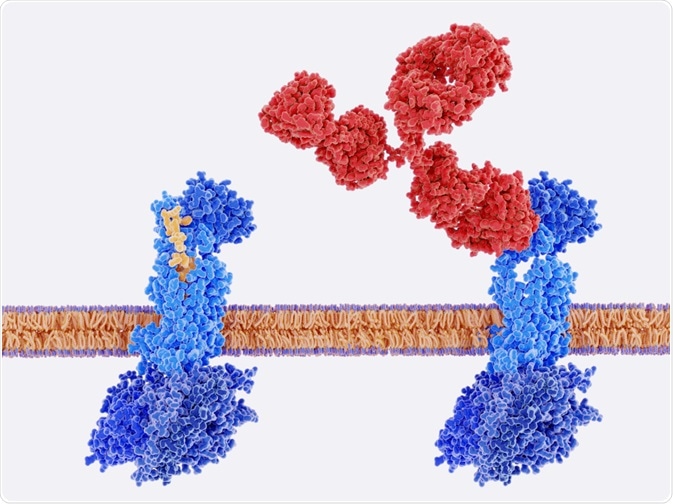Home » Health News »
What are DREADDs?
"Designer Receptors Activated Only by Designer Drugs" (DREADDs) belong to a class of proteins called chemogenetic proteins. These engineered proteins allow scientists to control nerve cell activity in ambulatory animals.
 Juan Gaertner | Shutterstock
Juan Gaertner | Shutterstock
How do DREADDs work?
DREADDs allow G-protein-coupled receptors to respond to synthetic ligands and not their natural ligand, acetylcholine. They are activated by a molecule called clozapine-N-oxide (CNO) which is biologically inert.
G-proteins are important cell signaling molecules, and researchers can investigate cell function in living organisms by modulating this signaling in time and space. The greatest use of DREADDs is in neuroscience because CNO can easily cross the blood-brain barrier.
Various DREADDs couple to different G-protein receptor types, such as Gi, Gs, and Gq. Any of these can be selected depending on the cellular pathway to be activated or inactivated.
These proteins are typically used to study nerve pathways, diabetes, metabolic disorders, Parkinson’s disease, alcohol abuse, post-traumatic stress disorder, depression, and to regulate behaviors in mice reacting to drugs and in drug addiction.
What are the properties of DREADDs?
DREADDs are mutant muscarinic receptors that are screened for the following characteristics:
- Low constitutive activity;
- High ligand affinity;
- High specificity to the synthetic ligand.
How do DREADDs act?
DREADDs are proteins manipulated to react specifically with small molecules which act as chemical actuators, but which were not previously recognized by these proteins.
A viral vector inserts the gene that encodes the engineered (mutant) G-protein-coupled receptor (GPCR) protein into the cell to be studied. Various promoters help select the target cells. The infected cell takes two or three weeks to express the engineered receptor protein which is activated using CNO.
Types of DREADD
hM3Dq is one of the earliest DREADD, derived from the human muscarinic receptor hM3 by two point mutations. It is very sensitive to CNO, but insensitive to acetylcholine and has low levels of constitutive activity.
hM4Di is an extensively used inhibitory DREADD. Others include the hM2D, kappa opioid receptors, Gs-coupled DREADDs (GsD), which are chimeric receptors (containing turkey and rat receptor regions).
DREADDs versus optogenetics
DREADDs allow researchers to control GPCR signaling more readily than optogenetics. They allow cellular switches to be turned off or on using the injection of CNO, without the need for fiber-optic arrays. Only cells that express the viral vector will be affected, improving research results.
The somewhat slower rate at which DREADD reactions occur might be a disadvantage. However, this method uses the cells’ own GPCR signaling pathway. This is in contrast to optogenetics, wherein the opening of artificial channels allows ion flow into the cell when the latter is exposed to bursts of light. Secondly, the slower rate allows cell processes to be studied for a longer period.
The rapid clearance of CNO is another advantage since it allows time control over the pathway and also repetition of the same dose if required.
What are the challenges of working with DREADDs?
DREADDs must have low levels of constitutive activity, to avoid signaling even when there is no ligand binding. Another problem is the possibility of desensitization and downregulation of the receptors while using DREADDs, which would reduce the strength of the responses. The degree of desensitization depends on the receptor reserve. GPCR signaling may activate more than one downstream effector pathway, resulting in either enhancing or silencing neural activity.
New DREADDs are being created using directed molecular evolution with a yeast-based platform. Another way is to dock small molecules against GPCRs for which they have available structures (structure-guided docking). New compounds must be able to penetrate the central nervous system easily to allow accurate evaluation of chemical actuators across the GPCR gene. The target could also be refined to sub-domains such as axonal targeting, dendritical targeting, or spine-specific targeting.
However, a recent study on the in vivo mechanism of action of CNO on the DREADDs has reported that the receptors are activated by clozapine. CNO can convert rapidly in the body to clozapine, which can cross the blood-brain barrier with ease and bind to the DREADDs in the brain. The injection of clozapine at subthreshold levels can thus bring about the distinct behaviors mediated via DREADDs.
Sources
- https://www.ncbi.nlm.nih.gov/pmc/articles/PMC4759656/
- https://bitesizebio.com/35850/introduction-dreadds/
- https://www.ncbi.nlm.nih.gov/pmc/articles/PMC4792665/
- www.the-scientist.com/…/chemogenetics-doesnt-work-like-many-thought-31127
- http://science.sciencemag.org/content/357/6350/503
- www.pnas.org/…/5163
[further reading: DEA
Last Updated: Feb 6, 2019

Written by
Dr. Liji Thomas
Dr. Liji Thomas is an OB-GYN, who graduated from the Government Medical College, University of Calicut, Kerala, in 2001. Liji practiced as a full-time consultant in obstetrics/gynecology in a private hospital for a few years following her graduation. She has counseled hundreds of patients facing issues from pregnancy-related problems and infertility, and has been in charge of over 2,000 deliveries, striving always to achieve a normal delivery rather than operative.
Source: Read Full Article



